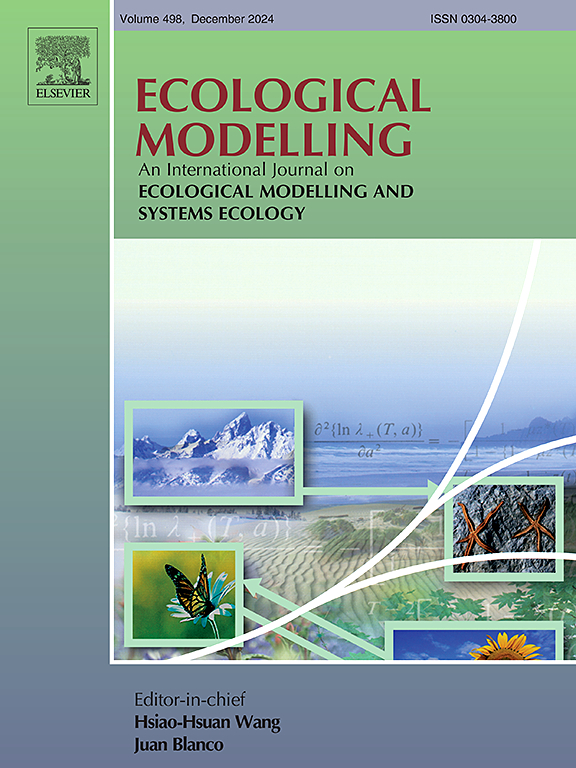Unveiling the impacts of noise pollution on marine fish community dynamics
IF 2.6
3区 环境科学与生态学
Q2 ECOLOGY
引用次数: 0
Abstract
Anthropogenic noise pollution is increasingly recognized as a critical threat to marine ecosystems, with well-documented impacts on fish physiology at the individual-level. However, a significant research gap remains in understanding how these individual-level disruptions scale up to influence community and ecosystem dynamics. To address this, we expand a size-based marine fish community model to incorporate noise-induced disruptions across four physiological pathways: food intake, energy expenditure, mortality, and reproductive output. Our results reveal that the total fish biomass declines across all pathways as noise increases, with particularly pronounced declines when energy expenditure, mortality, and reproduction are impacted. Demersal fish exhibit resilience to multiple disturbances, whereas large pelagic fish are highly sensitive to noise-induced increases in energy expenditure and mortality. The overall impact of noise on fish community depends not only on the severity of physiological disruptions, but also on the combination of functional types affected and the physiological pathways disturbed. Our model underscores the role of compensatory dynamics among fish functional types, which can buffer community biomass declines and expand regions of stable coexistence, even when large pelagic fish face extinction. However, severe noise impacts still pose risk of system collapse, with potential extinctions across all fish functional types. These findings emphasize the significance of compensatory dynamics in enhancing system stability against underwater noise. Our study provides new insights in understanding the community-level impacts of noise pollution, highlighting the need for further field studies and comprehensive noise regulations to ensure ecosystem stability and biodiversity conservation.
揭示噪声污染对海洋鱼类群落动态的影响
人为噪声污染日益被认为是对海洋生态系统的严重威胁,在个体层面上对鱼类生理产生了充分的影响。然而,在理解这些个人层面的破坏如何扩大到影响社区和生态系统动态方面,仍然存在重大的研究差距。为了解决这个问题,我们扩展了一个基于大小的海洋鱼类群落模型,将噪音引起的破坏纳入四个生理途径:食物摄入、能量消耗、死亡和繁殖产出。我们的研究结果表明,随着噪音的增加,所有途径的鱼类总生物量都在下降,当能量消耗、死亡率和繁殖受到影响时,下降尤为明显。底栖鱼类对多种干扰表现出弹性,而大型远洋鱼类对噪音引起的能量消耗和死亡率的增加高度敏感。噪声对鱼类群落的总体影响不仅取决于生理干扰的严重程度,还取决于受影响的功能类型和受干扰的生理途径的组合。我们的模型强调了鱼类功能类型之间的补偿动力学的作用,即使在大型远洋鱼类面临灭绝时,它也可以缓冲群落生物量的下降和扩大稳定共存的区域。然而,严重的噪音影响仍然存在系统崩溃的风险,所有功能类型的鱼类都有可能灭绝。这些发现强调了补偿动力学在提高系统抗水下噪声稳定性方面的重要性。我们的研究为理解噪声污染对社区的影响提供了新的见解,强调了进一步的实地研究和综合噪声法规的必要性,以确保生态系统的稳定和生物多样性的保护。
本文章由计算机程序翻译,如有差异,请以英文原文为准。
求助全文
约1分钟内获得全文
求助全文
来源期刊

Ecological Modelling
环境科学-生态学
CiteScore
5.60
自引率
6.50%
发文量
259
审稿时长
69 days
期刊介绍:
The journal is concerned with the use of mathematical models and systems analysis for the description of ecological processes and for the sustainable management of resources. Human activity and well-being are dependent on and integrated with the functioning of ecosystems and the services they provide. We aim to understand these basic ecosystem functions using mathematical and conceptual modelling, systems analysis, thermodynamics, computer simulations, and ecological theory. This leads to a preference for process-based models embedded in theory with explicit causative agents as opposed to strictly statistical or correlative descriptions. These modelling methods can be applied to a wide spectrum of issues ranging from basic ecology to human ecology to socio-ecological systems. The journal welcomes research articles, short communications, review articles, letters to the editor, book reviews, and other communications. The journal also supports the activities of the [International Society of Ecological Modelling (ISEM)](http://www.isemna.org/).
 求助内容:
求助内容: 应助结果提醒方式:
应助结果提醒方式:


